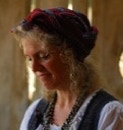Singer, Hammered Dulcimer Player, Storyteller
Faire Music
Buy this Album on iTunes
Wild Mountain Thyme
I have fallen in love with this melody. The song, sometimes attributed to Francis McPeake, is most likely derived from an old Scottish air. It has, in good folk tradition, been changed and adapted to speak to many generations of listeners. My version of this piece is traditional, in line with the story found in Robert Tannahill’s poetic works from the late 1700s.
Si Bheag Si Mhor
“Little Hill Big Hill” by Turlough O’Carolan. An old myth says that the hills which inspired this tune are actually not hills, but rather they are enchanted giants who fought a terrible battle in County Meath, Ireland. The fierce rivals did not stop until a wizard turned them into hills. This may be O’Carolan’s first composition.
Star of the County Down
If you recognize this tune from church, that is because the music is used in several hymns. It is referred to as Kingsfold and has been adapted for many, many poems and stories. This is my favorite secular version because our hero won’t rest until the lady is a “smiling bride” by his fireside. He has clearly discovered the secret to all good marriages - the happy wife.
Scarborough Faire / Child Ballad 2
The older versions of this story are great fun. The elven knight, so accustomed to getting any lady he sees, is annoyed and yet entertained by the maiden who begs to be left a maid. The fuller version could take an entire evening as the two exchange verbal repartee. I have created my own short version that I hope retains the spirit of the early elven knight tales.
Rights of Man
This Irish hornpipe celebrates the French revolution - passion, hope, heartbreak. I could play and improv using this tune for hours; it is rather addictive. This is my own improvised version.
Sally Gardens
A sally is an area by the riverbank where roof thatching is grown. These lyrics were penned by William Butler Yeats around 1889 as he wandered by the sally gardens in Sligo, Ireland. The melody is poignantly sweet.
Drink to Me Only
Ben Jonson, heartbreaker extraordinaire of the 1610s, wrote this song using poetic ideas borrowed from a Greek erotic love letter. He called it a Song to Celia. This piece celebrates flirting, the international language of the ages.
Fanny Power
O’Carolan wrote this planxty for Fanny Power Trench in the 1730s. I wish I could have met the heirless who inspired this regal tune.
Raggle Taggle Travelers
The lady who leaves her life of privilege to run off with the travelers is an ancient and oft told tale - love trumping practicality. Our heroine here is an adventurous spirit. My rendition is based on a Scottish story known also as Child Ballad 200.
Greensleeves
This melody is so compelling that six different versions were published in its first year, 1580. By 1686, the melody moved from the courtly celebration of romance into the sacred genre where it still lives today as What Child is This. I try to capture the original spirit of supplication.
Captain O’Kain
Another Turlough O’Carolan piece. Although he wrote for harp, his works are perfect for hammered dulcimer, and I think, highly hummable. This tune is one of my personal ear worms.
Danny Boy
The tune is known as Londonderry Aire. The song is well nigh an anthem for Americans of Irish heritage, and arguably one of the most popular songs of the early 1900s.
© Kathleen Johnson 2012-2016

